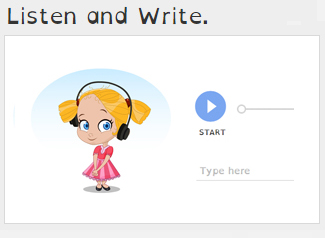Dictation
Dictation is an excellent tool to teach spelling. To spell the word, the child has to understand the sound the letters make in the word. The next step is to decode the word. The final step is to write the word. Dictation exercises are especially useful for struggling readers.
How is this activity organised?
There are twenty six sections in this activity. Rhyming words are used in this activity. Rhyming words help children to see the patterns in spelling. They learn to spell similar sounding words.
In sections one to nineteen, each section has a set of rhyming words. For example, section one has words ending in ate and section two has words rhyming with day. In sections 20 to 26, words used in sections 1 to 19 are included as revision exercises.
Does your child have spelling difficulties? This activity helps you to make an assessment of your child’s ability to spell. Observe your child while she/he is doing this activity. Which are the words that cause difficulty for your child? Does your child read well? Can your child copy a passage without making too many mistakes?
Dictation is a good remedial action to improve spelling.
Tips for parents
- Dictation of words and passages
If your child struggles to read and spell, give dictation. Start with two letter and three letter words. Use rhyming words as much as possible. Explain the meaning of the words and teach your child how to use these words in sentences. Ask your child to tell sentences with the words that are used in dictation. www.manythings.org is an excellent site for sentence examples. Dictate words that are familiar to your child.
When you dictate words, include words which your child can spell well. Getting some answers right would give your child the much needed confidence and a feeling of “I can do”. Make the list of words for dictation short. It would be better if the list does not contain more than twelve words.
After the exercise is over, ask your child to check the answers. After this round of correction is over, show your list of words. Ask the child to self correct. Self correction is a powerful tool to improve spelling. It is much better than someone else pointing out the mistakes.
Dictate small passages. Let the child read the passages chosen for dictation. Explain the meaning of the words used in the passage and give as much information about the topic. The child would be comfortable taking down a familiar passage. Ask the child to check before handing over her/his answers.
Show the passage dictated. Ask the child to self correct.
A struggling reader may require more than three or four dictation exercises in a day.
- Make the child aware of sounds letters make
Some children struggle to read and spell because they are not aware of the sounds that letters make. Prepare carefully the list of words for dictation. Few examples are given below. For beginners, use rhyming words.
hot
bet
play
ten
hotter
better
player
tend
host
beat
playing
tent
hostel
best
played
net
hosts
bent
clay
nest
shot
bitter
pray
neat
short
fitter
prey
next
Read out the words slowly emphasizing the sound of each letter in the word. Ask the child to repeat the words and tell you the sounds she/he hears. Some children may be able to make out the first and the last sounds of a word. Let them write these down and ask them to identify the remaining sounds in the word.
- Dictation need not always involve writing.
Some children have poor working memory. Oral dictation can be used to improve working memory of these children. Dictate a small sentence and ask the child to repeat it. Gradually increase the length of the sentences. Select sentences which appeal to your child.
Show pictures to your child. Ask her/him to tell sentences based on the pictures. After an hour or so, ask your child to recall the sentences she/he had made. These exercises would improve your child’s ability to store information and recall them when needed.
- Picture dictation
Picture dictation is a fantastic tool to develop your child’s ability to describe.It is an excellent method to improve vocabulary. To get the best results, prepare a list of commonly used verbs, adjectives and adverbs. These can be downloaded from the net. Use these to describe the pictures.
The internet is an excellent resource for getting pictures. You can search for images of parks, children playing, animals, restaurants with people dining, birthday cakes, etc. The list is endless! Any picture can be used for dictation.
Ask the child to describe the picture. Make her/him tell a story. These activities would improve the imagination and creativity of your child. Dictate the story.
- Teach spelling rules
Learning spelling rules help children to see the patterns in spelling. There are many sites which explain spelling rules. Exercises based on spelling rules can be downloaded.
- Use rhyming words
Rhyming words are a great tool to improve spelling. Use rhyming words when giving dictation.
Search the net for spelling and syllabication rules. You can use rhyming words, words having double letters and words having consonant blends etc for dictation. Search the net to prepare a list of words, suitable for your child, for dictation.

